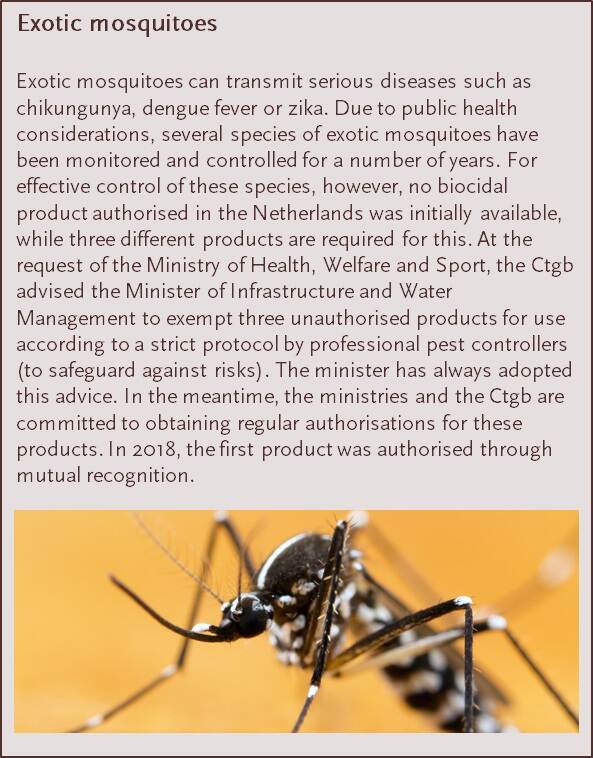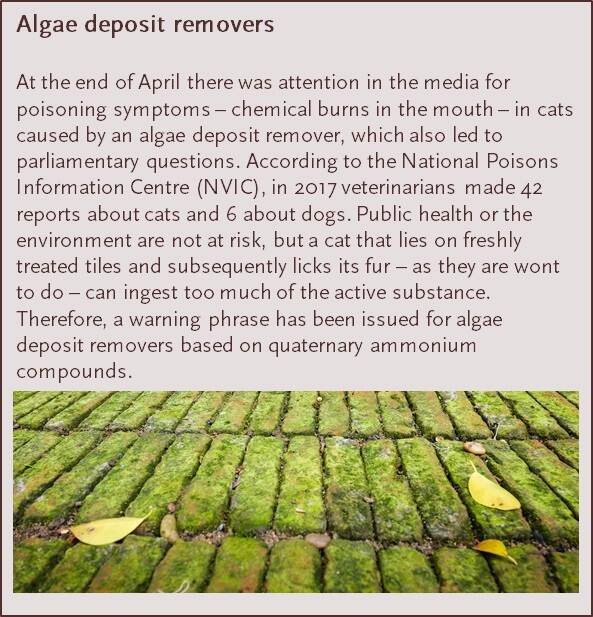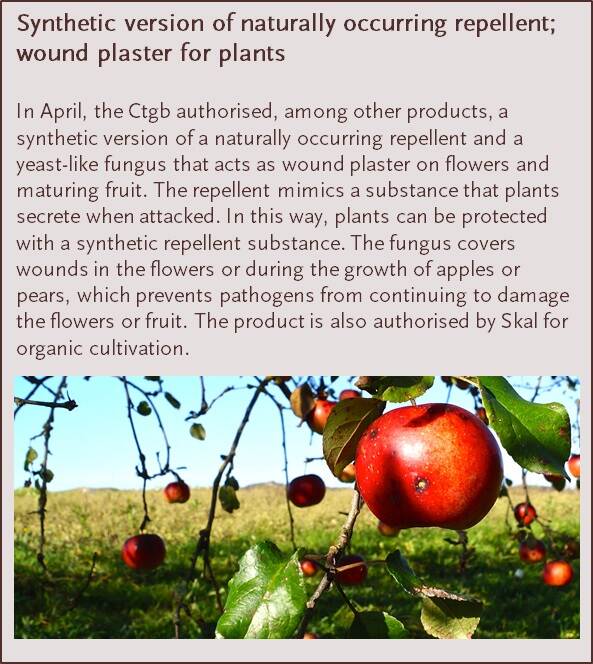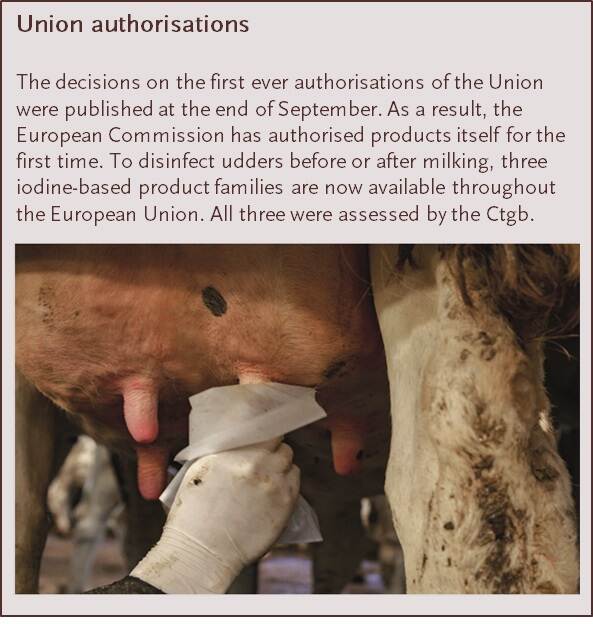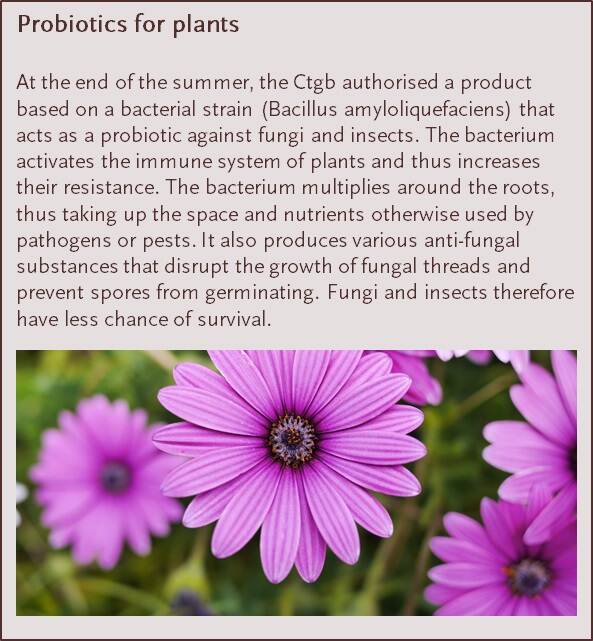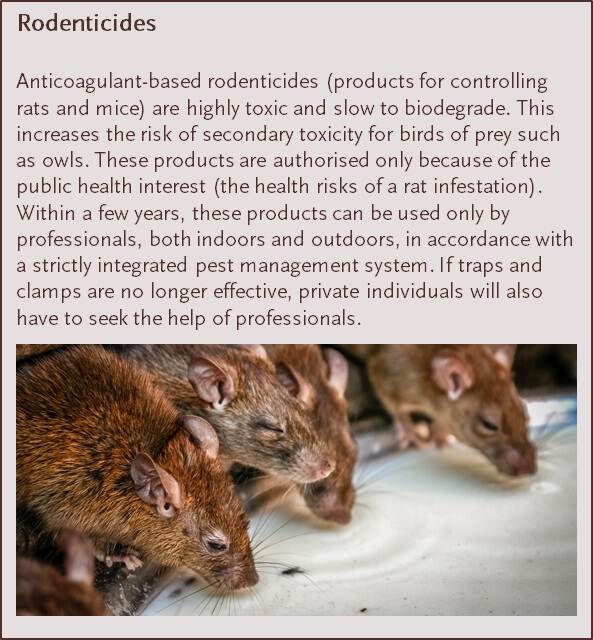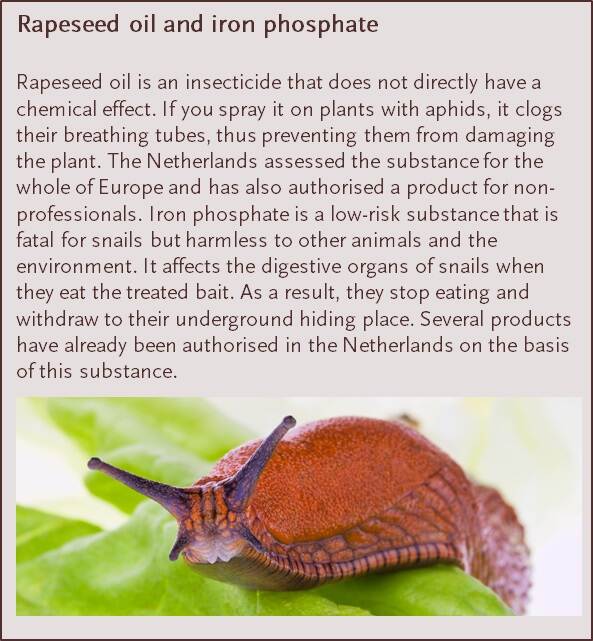Annual Report 2018
Preface
During the year under review, the Board celebrated its 25th anniversary. We acknowledged this milestone as part of the New Year's meeting, on the Ctgb client contact day and the symposium on risk perception. Due to the changing and increasing political and societal interest in plant protection products and biocidal products in recent decades, we titled this symposium Tussen brein en onderbuik (Between reason and emotion). There is also more interest on the European level: the European Parliament holds more meetings on this topic than it did 25 years ago. This is not only because more is known about this topic scientifically, but also because citizens have become more assertive, governmental authority is not always accepted as self-evident and if we are not careful, confidence in authorities will erode. These trends are not only evident in our sphere of activity, but also more broadly in society. This feeds the tension between emotion and reason concerning developments and issues in our field. It is precisely because of this emotion that the Ctgb must be an organisation that is predictably consistent and trustworthy in its activities and decisions.
Based on the nature of our work, this means that we must effectively explain the difference between a hazard-based approach (potential health or environmental hazard) and risk-based approach (in which risk is proportional to exposure). A hazardous substance can become a risk to humans, animals or the environment due to a certain degree of exposure to the substance. The concept of exposure is thus crucial for our work. Intense debates are held about whether or not to authorise products and about restrictive measures. But in that process the actual usage of a product is often disregarded, while this is often the most important consideration regarding effects on the environment or on public health. Reduction in usage may in many cases achieve more than adversarial discussions for or against a certain product. This can unite reason with emotion.
Communication, and risk communication in particular, is thereby the most important tool for restoring trust where it has been lost and maintaining trust where it is subject to erosion. In this communication one must respect and appreciate different viewpoints, even when values are dominant that lack scientific and rational support. These values must also be given due consideration. It is important that we communicate well and in a timely manner based on factual and scientifically sound information, and thus contribute to enabling stakeholders and citizens to form well-founded opinions.
The political and societal debate is evolving towards more sustainability, circular agriculture, integrated pest management, the use of modern digital techniques and other developments. These developments will influence the measures to be taken in our work based on digital farming or modern biocidal product applications such as cold plasma processing. As an organisation, we must respond effectively to these developments and utilise them.
New scientific developments make the assessment process increasingly complex at the substance level and product level, and at both European and national levels. This makes great demands on the organisation to meet the demand for our services while charging acceptable fees and offering the shortest possible turnaround times. The Ctgb expanded again last year as an organisation, many employees have started to work more flexibly and specialists in in plant protection have developed new expertise so they can be deployed for making biocidal product assessments. This has enabled the organisation to respond more efficiently to fluctuations in numbers and types of applications. The organisation has more control over scheduling and delivers what it promises.
The organisation is also financially sound.
These developments have not gone unnoticed in the outside world. The appreciation for the organisation, the ‘customer satisfaction’, has increased, which is confirmed by benchmarking and certification. The positive assessment of the international review/visitation committee during the year under review underlines this. According to the committee, the Ctgb has developed in recent years into a stable, reliable and predictable professional organisation that delivers high quality work and is oriented towards the future.
To continue this upward line and to be able to embed scientific and innovative developments in the authorisation process, the Board will also have to invest sufficient time and attention.

The intention is to no longer distinguish between deputy members and full members; to do our job well we need all members of the Board and their specific expertise. This was one of the conclusions that emerged from the annual evaluation of the Board’s performance.
The steps that the organisation has taken in recent years have only been possible due to the willingness and commitment of the employees to make this possible. We will maintain that course and endeavour to develop even further with the aim of continuing to meet the high expectations of society and its elected representatives.
Johan F. de Leeuw, chair
Annual overview: 2018 in a nutshell
The Board for the Authorisation of Plant Protection Products and Biocidal Products (Ctgb), celebrated its 25th anniversary on 1 January 2018. The Ctgb is the Dutch competent authority for plant protection products and biocidal products. It assesses plant protection products and biocidal products for safety and effectiveness, and decides whether or not to authorise them. It does so not only for products for agriculture and horticulture, but also for disinfectant products for hospitals, swimming pools, cooling towers or home use, antifouling paints or products that control rodents. If the Ctgb authorises a product, it means that it is effective and safe for humans, animals and the environment if used correctly. In addition, the Ctgb provides solicited and unsolicited advice to various ministries.
The anniversary was thoroughly acknowledged at the New Year's meeting, the Ctgb client contact day in June and a symposium in the autumn on risk communication and risk perception. Since the first Board meeting 25 years ago, the Chairman has pointed out four major trends in the authorisation practice of plant protection products and biocidal products: 1) a shift from national to European legislation and regulations; 2) a shift from chemical control to integrated and green control; 3) a shift from general, broadly effective products to specific, ‘personalised’ products; and 4) more transparency and public interest. These trends formed the context of the Ctgb client contact day. The Chairman called for ample room for all kinds of innovation.
The increased public interest was also the subject of the symposium ‘Between reason and emotion’ in November. Risk perception has now become a discussion about values, in which scientific evidence is doubted by the public, which presents different values in opposition. To cope with that, the Ctgb must not only be reliable, consistent and predictable – as it has been for 25 years – but must also respect the different perceptions of the public. Citizens today are different than those from 25 years ago.
Decisions
In 2018, the Board made 196 decisions on applications for plant protection products and 70 decisions for biocidal products. Multiple authorisations are often issued for a single product due to multiple authorised uses. The Ctgb authorised 88% of the requested uses of plant protection products and 87% of the uses of biocidal products. Of the requested uses, 12% and 13%, respectively, were rejected or withdrawn by the applicant because of risks identified by the Ctgb during the assessment. For 69% and 46% of the requested uses, respectively, the conditions for use have become more stringent, so that consumers and growers can be confident that the products they buy and use are safe when used according to instructions.
The number of applications for plant protection products was higher than in 2017, but lower than estimated. The number of biocidal product applications increased strongly, partly due to the impending Brexit. In 2018, the organisation adapted to this changing demand by deploying employees flexibly. Experts in the assessment of plant protection products also acquired expertise in the assessment of biocidal products. About one-fourth of the Scientific Review Officers can now be deployed flexibly. The new biweekly planning system now is used in all teams and is beginning to have benefits. And after internal research into the turnaround times showed that time could be gained, especially in the intake phase of the application process, the intake process was modified accordingly. This is one of the reasons why the Ctgb will be able to comply with the statutory turnaround time for applications for plant protection products in 2019.
Authorised products and active substances
The Ctgb reports annually how many products are authorised in the Netherlands and how many different active substances these products contain. The figures below show that the number of products (and active substances) has increased slightly in the last 10 years. However, representatives from agriculture and horticulture have voiced concerns about an impoverishment in the product assortment. Certain sectors have few or no products at their disposal. Consequently, the figures presented here provide little information about the diversity of the product assortment.
Authorised products and active substances
| Biocidal products | Plant Protection Products | Active substances PPP | Active substances biocides | |
|---|---|---|---|---|
| 2007 | 759 | 697 | 218 | 81 |
| 2008 | 799 | 699 | 226 | 79 |
| 2009 | 805 | 759 | 232 | 80 |
| 2010 | 829 | 766 | 238 | 83 |
| 2011 | 863 | 771 | 252 | 92 |
| 2012 | 997 | 777 | 256 | 116 |
| 2013 | 1188 | 800 | 257 | 123 |
| 2014 | 1404 | 845 | 262 | 145 |
| 2015 | 1476 | 907 | 271 | 150 |
| 2016 | 1508 | 916 | 279 | 151 |
| 2017 | 1559 | 941 | 277 | 155 |
| 2018 | 1653 | 1000 | 285 | 160 |
You can switch on / off individual items in the legend to customise the graphic.
Evaluations
The organisation was evaluated from various perspectives in 2018. The European Commission (Directorate F) visited the Netherlands as part of a fact-finding mission concerning the implementation of the Biocidal Products Regulation (BPR). This visit was aimed at several authorities in the Netherlands, including the enforcement authorities. An important topic of discussion for the Ctgb was the increasing complexity of the European authorisation process as a result of the introduction of the BPR. This means that more hours are needed for European coordination per application, which places a larger burden on the available capacity. As a result, the turnaround times at the Ctgb have become longer, in some cases even longer than the statutory maximum turnaround time. In the second quarter, Certiked conducted an audit based on the new ISO:2015 standard. No shortcomings were identified, the recommendations were applied within the organisation and the Ctgb was recertified. In the stakeholder survey at the end of the year, the general appreciation increased by half a point, and here too, meeting the deadlines – including their relationship with the invoiced costs – was the most important point of attention.
Five years after the first assessment, an international visitation committee reassessed the Ctgb in 2018. The committee examined the scientific process, the scientific results and the decision-making process of the Board, and concluded in its report that the Ctgb is an expert and internationally valued organisation, both within and outside Europe. The quality of the risk assessment of plant protection products and biocidal products in the Netherlands comfortably meets the scientific requirements: Ctgb authorised plant protection products and biocidal products therefore meet the safety requirements for humans, animals and the environment.
Sustainability
In September, Minister Carola Schouten of Agriculture, Nature and Food Quality published her vision of the future of agriculture, Agriculture, nature and food: valuable and connected: the Netherlands as a leader in circular agriculture. In this document, she opts for a switch to circular agriculture in 2030, with as little waste as possible, whereby as few harmful substances as possible are released, and whereby raw materials and end products are used with as few losses as possible. With this publication, she has given a new direction to the pursuit of sustainability.
In 2018, the Ctgb participated in various innovative sustainability projects based on integrated pest management (IPM), such as the Pilot Projects on the System Approach led by LTO. Where possible, the Ctgb contributes to making crop protection more sustainable. To protect crops, more and more bacteria, viruses and plant extracts are being used, often in combination with other products. (See boxes.) Many of these products are based on low-risk substances or potentially low-risk substances. The GreenTEAM of the Ctgb specialises in the assessment of these bio-pesticides. In addition to regular assessment work, this team also provided presentations on current topics at conferences including Artemis, ABIM, Crop Innovations and Regulations, Foodlog, Fresenius, and SETAC. Members of the GreenTEAM also participate in official EU task forces. With these efforts, the Ctgb is contributing to the further development of the assessment methodology for green plant protection products.
Of the 120 plant protection products authorised in 2018, 17.5% (21) were low-risk or potentially low-risk. Eight products were authorised on the basis of a low-risk substance and five of them were authorised as a low-risk product. To be authorised as a low-risk product, risk mitigation measures for safe use (such as gloves) are not allowed not be prescribed.
The authorisation of low-risk products is subject to a shorter statutory turnaround time of 120 days, with an extension of a maximum of six months for the applicant to answer additional questions. To be able to achieve this statutory turnaround time in 2019, the Ctgb adapted its internal processes in 2018. The Ctgb uses this accelerated procedure for zonal applications for products based on low-risk substances, and also for applications based on substances that the European Commission has designated as potentially low-risk substances. In Europe, guidance documents on the definitive procedure and interpretation of the low-risk criteria are still under development. However, the Ctgb does not consider this to be a reason to wait before implementing the reduced statutory turnaround time.
Europe
As the Dutch competent authority, the Ctgb works within the European frameworks of the Plant Protection Products Regulation and the Biocidal Products Regulation, supplemented if necessary by national legislation. The details of the European Regulations are still being specified. Guidance documents are constantly being developed for further specification. The Ctgb actively contributes to this process and works closely with the European Food Safety Authority (EFSA), the European Chemicals Agency (ECHA) and the competent authorities of the other European Member States. In the Netherlands, the Ctgb works closely together with various ministries, the Netherlands Food and Consumer Product Safety Authority (NVWA), the Human Environment and Transport Inspectorate (ILT) and research institutes such as the Netherlands National Institute for Public Health and the Environment (RIVM) and Wageningen University & Research (WUR). European cooperation is aimed at harmonisation. This means that products are assessed in the same way in all Member States of the European Union.
In recent years, however, the outcome of the European decision-making process on active substances has become more political and less predictable. Expert recommendations are no longer always taken into account. This happened again in 2018: there were political discussions on neonicotinoids that resulted in restrictions, and there were also discussions about hormone-disrupting substances for which new scientific criteria were established and new guidances went into force. For the active substances for plant protection products and biocidal products, this process leads to more detailed provision of information and to discussions, and therefore to delays. For biocidal products, the legislation is even newer, which causes interpretation to be especially unclear. For applicants, strict authorisation criteria and a strict assessment are less of a problem than uncertainty and unpredictability. The unpredictability of the outcomes of the authorisation process makes the European market less attractive for producers and there is a chance that they will seek better conditions outside Europe. By allowing this unpredictability, Europe is putting itself at a disadvantage, with possible loss of market share as a result.
The Ctgb is confronted with this situation as an implementation body, and tries to increase predictability, also regarding procedures, within the new context. With regard to the substance dossiers for plant protection products, the Netherlands is working together with Germany to improve cooperation between EFSA, the Member States and the European Commission, and thus increase predictability for applicants. Regarding the recommendations of EFSA and the Member States to the Standing Committee on Plants, Animals, Food and Feed (SCoPAFF), this process focuses on clarifying the arguments, considerations and dilemmas as much as possible to facilitate decision-making in SCoPAFF. With biocidal products, the Ctgb is trying to improve this process, especially at the early stages, for example by developing guidances and models jointly with other Member States.
EU authorisations for biocidal products
On the other hand, the scope of ‘special’ authorisations, such as simplified authorisations and Union authorisations, is becoming increasingly visible under the European Biocidal Products Regulation. The first authorisations of biocidal product families for the entire European Union were published at the end of September. For the first time, the European Commission itself authorised products that can now be placed on the market in all Member States. Three of these first Union authorisations were assessed by the Ctgb. The other two were obtained through a Same Biocidal Product procedure. (See box on the left.)
In May, the Board approved the first ‘simplified authorisation’ for a biocidal product family. Such a simplified authorisation is possible for products based on recognised low-risk substances. These can be placed on the market throughout the EU after being authorised in one European Member State. Notification of the national competent authorities is sufficient. For example, granules with lavender oil, peppermint oil and citronella are now authorised for use in plastics. This is an example of a product that is used to protect electricity cables against rats or termites.
RUB list revocation
In 2018, a large part of the ‘RUB list’ was revoked. All plant protection products and biocidal products must be assessed according to European Regulations. However, the Netherlands still had a number of exceptions: substances with uses that are allowed on the market on the basis of the previous Pesticides Exemption Scheme (RUB). In 2012 it was agreed that the RUB products will either be authorised on the basis of European Regulations or will be withdrawn from the market. Some of these products have been subject to this exemption in the Netherlands for years. Applicants could register RUB products for authorisation until mid-February. The Ctgb published a list of the registered products in the Staatscourant (Dutch Government Gazette). Non-registered RUB products were withdrawn from the market after 1 October 2018 and may no longer be used after 1 October 2019. Registered products remain on the list during dossier preparation and assessment and may be used until a decision has been made on the application. These products are assessed according to the provisions in European Legislation for safety for humans, animals and the environment and ultimately receive a regular authorisation or are withdrawn. As a result, the RUB list will eventually disappear altogether.
Safety
The Dutch and European assessment and authorisation process is aimed at guaranteeing the safety of humans, animals and the environment. Due to new insights, regulations and authorisations regularly become increasingly stringent. Important in 2018 were the European dossiers for neonicotinoids and rodenticides based on anticoagulants.
In late April, the European Commission restricted the use of products based on imidacloprid, thiamethoxam and clothianidin to “crops that stay within a permanent greenhouse for their entire life cycle”. The Commission indicated that this life cycle ends before harvest. Consequently, the sales of treated products such as harvested cut flowers, tomatoes or head lettuce remains possible. The Ctgb implemented this ruling with its decision to allow these three neonicotinoids to be used exclusively in closed, permanent greenhouses. To protect bees and other pollinators, plants and seeds treated with the three substances may not be planted outside. These regulations also apply to bulbs and seeds intended for export outside the EU.
The use of imidacloprid-containing plant protection products was already subject to stricter requirements in the Netherlands than those in the Activities Decree Environmental Management. They may only be used in a greenhouse without discharge – which must be proven with a certificate – or the waste water from the greenhouse must be purified before discharge with efficacy of at least 99.5%. The filtering installation must actually be in use and be adequately maintained, which must be demonstrated with a certificate. Certification of this purification system has been possible since the end of 2017; after July 2018 it was also possible to certify ‘zero discharge’ based on a visitation report from the corresponding water board. This shows that investing in sustainability measures, such as purification systems, pays off and in this case it translates into maintaining the assortment of products.
Regulations are also becoming more stringent for biocidal products. At the next re-registration (around 2023), the use of anticoagulant-based products to control rats and mice will be restricted to certified professionals. Both indoors and outdoors, these products can only be used in the Netherlands according to a strictly integrated pest management system (IPM) for controlling both rats and mice. In the future, private individuals will also need the help of professional pest controllers. (See box on the left.)
In July, RIVM published a report entitled ‘Health survey on people living in the direct vicinity of agricultural plots’, which was commissioned by the Minister of Health, Welfare and Sport. The aim of the reported study was to looks for link between agricultural practice and health. Because the Ctgb, as the competent authority, has the responsibility to assess new scientific information about potential risks of plant protection products, it also evaluated this RIVM study. The report showed that people residing in the vicinity of agricultural operations appear to be slightly healthier than the control group, and no statistical correlations were found between the health status of these local residents and their proximity to agricultural and fruit growing operations. The Ctgb sees this as a confirmation that the assessment system is robust for these local residents.
Appeals, objections and Freedom of Information Act requests
At the end of January, the Trade and Industry Appeals Tribunal (CBb) abolished the 2014 emergency measures for two plant protection products based on metam sodium. At that time, the Ctgb had decided to take the emergency measures due to an exceedance of the norm for local residents, as a result of which the likelihood of unacceptable risk was too great. Despite the decision of the CBb, the stricter conditions for use specified in the emergency measures were included in the legal conditions for use at the request of the authorisation holder. This meant that the risks for local residents were covered.
The Trade and Industry Appeals Tribunal ruled in April of 2018 on the long-running appeals procedure concerning the disclosure of studies on imidacloprid, which not only involved the Ctgb but also the Bijenstichting (Bee Foundation) and the authorisation holder, and referred the case back to the Ctgb. An objection hearing on this ruling was held in November. The Ctgb is now awaiting advice from the Advisory Committee on the objections and will then make a decision about the objections.
Public disclosure of studies remains a concern for NGOs; the Ctgb has also received requests for public disclosure on the decisions of September 2018 which withdrew authorisations of a number of neonicotinoids-based products or restricted their use exclusively to greenhouses. However, these decisions were not based on studies conducted by applicants.
Last year, the Ctgb also made a number of decisions based on the Freedom of Information Act. One of these was a request for public disclosure of contacts of officials, including members of the Board, with the business community. In its response the Ctgb stated that there were no contacts other than incidental contacts during study days and the like.
Due to the growth and reorganisation of the Ctgb, the Regulations on Operations as well as the Mandate Decree have been amended. The Decree rules of procedure on regulations to authorise plant protection products and biocides have been adapted in accordance with the Plant Protection Products Regulation and the Biocidal Products Regulation.
Open data
In accordance with the principles of open data, the Ctgb and the NVWA have merged their authorisation and usage data in the authorisation database, which went online mid-December 2017. Until early 2018, the Ctgb and NVWA each had their own databases. The authorisation database of the Ctgb contained the authorisation decisions with information on the risks, regulations and efficacy of authorised plant protection products and biocidal products. The NVWA had a knowledge base with information on plant diseases and pests and methods to protect crops against them. The project and the link with the internal Ctgb systems were completed in the second quarter of 2018. Anyone can search the database, and the data meets ‘open standards’ so that IT providers can develop apps for users. They can link data from the database to crop data, such as specific plant protection products for potatoes, for example, but also to weather forecasts, fungi or other pests, and to growers' data. Several of these apps had already been developed and implemented in 2018.
Since its publication at the end of 2017, about 25,000 farmers and horticulturists, crop advisers, pest controllers and enforcers have searched the database more than 100,000 times for products that protect crops against a specific pest. Farmers and horticulturists want to know what products they can use, what the legally permitted doses are and how often they can use a product. NVWA inspectors consult the information to enforce these regulations.
Sharing knowledge
Via the website and during consultations, conferences and informative meetings and workshops, the Ctgb shared the knowledge gained in the risk assessments and development of guidances with European bodies, applicants, users, other competent authorities and interested parties. This year there were workshops on topics such as the national addendum for plant protection products and the drift reduction classifications from the new Activities Decree Environmental Management.
The secretary/director again wrote a number of well-read columns in the professional journal De Boerderij, and his monthly preface for the Ctgb E-zine was frequently shared via social media and led to various articles in professional journals. In particular, the professional agricultural journals regularly publish information about Ctgb decisions. The attention for biocidal products is more fragmented. In 2018, however, the Ctgb did publish various articles in professional journals in this field last year, including changes to the labels under the Biocidal Products Regulation and about products to control rats and mice. The Ctgb also participated in an interview for a professional journal in the metals sector. A story about the authorisation database was written and submitted to journals in the IT sector, and the Ctgb also provided an article to an international biocidal products journal. For NGOs, such as Stichting Bollenboos, Dierenbescherming, Bijenstichting, Stichting Natuur en Milieu, and Landschappen.nl, a meeting has been arranged to discuss the work of the Ctgb with them and their opinions about this work.
Social media
The number of followers on Twitter increased from 1,383 to 1,521 (+138). A total of 133 tweets were issued: 109 about online news articles, 24 about monthly announcements. The tweets with societal impact (risks, exposure of local residents and the like, but also with #Brexit) clearly have more interest and a greater reach through retweets than the more procedural tweets. The tweet with the largest reach, interactions and retweets was that of July 6 about the RIVM report ‘Gezondheidsverkenning #omwonenden van landbouwpercelen’ (‘Health outlook #localresidents of agricultural plots’), followed by a tweet about authorisations and withdrawals subsequent to the annual report 2017 and the tweet in April about the E-zine preface concerning the relativity of risk and perception.
In conversation with the industry
In March, as part of its 25th anniversary activities, for the first time the Ctgb held two ‘speed dates’ with growers with the aim of learning from users and user experiences. (See box on the left.) Growers of various crops travelled – sometimes over great distances – to the Ctgb to share their experiences. The growers in attendance and the participating Ctgb employees were very positive about the discussions. The growers indicated that they experienced a discrepancy between their day-to-day practice and legal conditions for use. They feel overly restricted by the prescribed maximum frequency in combination with a fixed concentration. They would much rather work with a maximum dosage of active substance per m2 or hectare, leaving the concentration and frequency up to the experienced grower; this would result in lower net usage. Several growers expressed their wish to use products on small affected areas without immediately forfeiting one application round for the entire growing operation. The Ctgb also sees this as an option in the development of integrated cultivation. Modern precision techniques (such as GPS) could help to monitor such use for enforcement purposes.
It also became clear that there is a great need for products for minor uses. The Ctgb cannot take any initiatives in this respect, but was able to clearly convey that organised growers, interest groups or the Fonds Kleine Toepassingen (Minor Uses Fund) can jointly promote the desired uses. If they determine that certain uses are sufficiently important, it is relatively simple to have several minor uses included on the label of a plant protection product. The costs for this are relatively low as well.
At the end of March, the Ctgb announced that more than 60 new minor uses were authorised at one time. One insecticide was authorised for 38 minor uses and can now be used to control thrips, aphids, beetles, caterpillars, flies and mosquitoes in crops ranging from poppy seeds, mustard, spinach family, pulses and tuber vegetables to potatoes. In that way, the Ctgb answered a question that had arisen during the speed date.
For floriculture, the Ctgb, in collaboration with the NVWA, made a classification into minor crop groups from an agricultural and risk perspective. Most crop groups are smaller than the maximum crop production area for minor crops, which means that applicants can apply for an extended authorisation with a minor use.
To meet the expectations of users, the Ctgb, together with the NVWA and the Dutch Water Authorities, also analysed the existing restriction sentences on enforceability and compliance. The result is a set of clearer sentences, in which a clear distinction is made between restriction sentences and alert sentences. The latter point to a possible risk with a certain use, for example, that the product damages other crops or pollutes the water, or warns for possible damage to pollinators or natural predators.
Organisation
The Ctgb is a professional organisation with satisfied employees and an informal working atmosphere. In 2018 this led for the second time to an award by Effectory en Intermediair: ‘Best employer 2018-2019’. The organisation has an ‘open door policy’ with excellent collegiality.
There were no major changes to the organisational structure in 2018. The team of project leaders was, however, split into a separate plant protection team and a biocidal products team. The span of control became too large for a single team leader. Both teams are now managed by their own team leader.
In 2018 the organisation grew again in a controlled manner – especially within the primary departments – to accommodate the larger workload (biocidal products). The Ctgb continues to succeed in filling its vacancies. At the end of 2018 the total workforce consisted of 157 employees (141.4 FTE), 3 employees more than in 2017.
Planning system
The Ctgb strives for optimum management of the primary process and better predictability of the progress of applications. In 2017, the Ctgb started working according to a new planning concept and the operational planning module of the associated planning application was also put into use. After further development of the new planning application, the final modules for tactical and strategic planning were implemented in 2018. With this planning methodology and application, the primary process can be managed more effectively, and the resulting insight into tactical planning means that the organisation can respond faster to changes in the required capacity.
Financial results
The Ctgb closed the year 2018 with a positive operating result of €460,000. A positive result of approximately €150,000 was estimated. The operating result for 2018 was credited to the general reserve. The negative equity has thus been converted into a positive equity consisting of a General Reserve of €308,000 and a designated reserve for IT of €500,000.
Risk management
The Ctgb had formulated a number of potential business risks for 2018 that could have an impact on the realisation of the tactical planning: insufficient capability to strengthen equity capital; continuation of excessive turnaround times; insufficient primary capacity; information security; the court ruling on public disclosure resulting in increased workload and objections and appeals resulting from applications not being processed within the statutory timelines. The organisation has taken the necessary measures to prevent or limit these risks.
In 2018 the first positive effects become apparent concerning shortening of the turnaround times for plant protection product applications. The focus on increasing output is starting to be effective. This was possible through better planning and management of work with the new planning methodology and planning tool. For biocidal products the increased workload still resulted in excessive turnaround times. The inability of the Ctgb to meet the statutory timelines for biocidal products was partly due to Brexit.
On a more positive note, the improved insight into activities and planning further enhanced the anticipation of personnel capacity. The Ctgb has anticipated the required capacity in a timely manner and controlled growth of the total workforce. In addition, substantial investments were also made in 2018 to make the organisation more flexible, which means that fluctuations in the workload can be dealt with more effectively.
Measures have been taken in various areas to prevent potential risks in information security: strict house rules that are enforced, building security, mandatory identification and visible pass requirement for visitors. A security officer has been appointed who, together with suppliers and European authorities, oversees the security of both digitally and physically stored information, electronic connections, applications and hardware. The Ctgb workplaces and infrastructure are protected in accordance with prevailing government standards, and the business applications are strictly separated from our public website. The IT and archive rooms are secured and information security is periodically audited internally and externally (annually by ECHA). Information security is constantly on the agenda and is constantly being refined. The architecture information planning (AIP) will lead to a reduction of the current application landscape. In addition, the Ctgb is investing in new systems and even more secure software and connections, and the role-based access to functionality and data has been strengthened even further.
Finally, a start was made in 2018 on designing a new information security policy in conjunction with the organisational policy.

